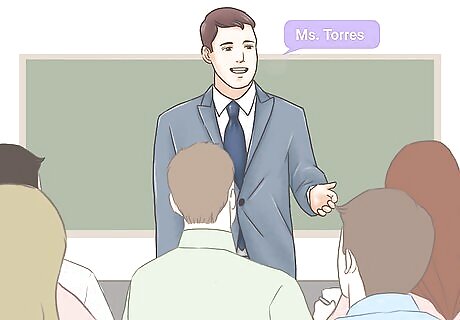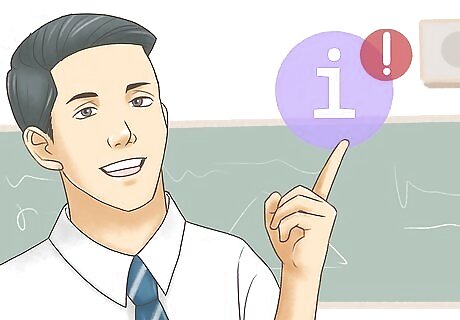
views
Redirecting Talkative Students

Use proximity to attempt to quiet the student first. Simply stand near the talking student to get them to quiet down. Without interrupting your instruction, move near the talker, continuing to talk. You may even place your hand on their desk or on their shoulder to gain their attention. It also helps to move about the classroom as you talk, which is called mobility and proximity. This way, you will be near each student every few minutes.

Keep your tone professional when addressing the talkative student. Don’t show your irritation or raise your voice, as it undermines your authority. Instead, stay calm and assert yourself. If you need to, take a deep breath to calm yourself before you speak.

Call the name(s) of the student or students who are talking. This is to get their attention so that you can address the talking. Give them a chance to stop talking before you tell them why you called on them or ask them a question.

Pause to signal that you need their attention. Without a pause, the students may hear their names but not what you said afterwards. This is especially true if they weren’t paying attention. Pausing for their attention will eliminate the back-and-forth that can happen if they don’t understand right away. This gives the student or students time to redirect their attention to you, rather than their conversation. If the students do not hear you, walk closer to them and call their names again.

Redirect the student to the desired behavior. Remind them of the classroom expectations that they agreed to. Depending on their age, you could remind them of a specific rule or your classroom quieting technique. What’s important is that you direct their attention to the positive behavior that you expect to see from them. For elementary students, you could remind them of your quiet down statement. Say, “Katie, we’re in ‘Hocus Pocus, Everyone Focus’ mode right now.” For middle or high school students, you could remind them of the classroom expectations. You could say, "In this classroom, we respect others when they are speaking by listening." At the college or university level, you could remind the student why they are there. Say, "I'm providing you the information you need to be successful, so it's important that you listen." Keep your focus on the main issue at hand, such as your need for everyone’s attention so that you can teach. Don’t get distracted by other issues, such as the student’s tone or the excuses the student gives for talking.

Say thank you and move on. This signals to the student that the issue is closed and not open for debate. Don't wait for the student to give a response, as that wastes more time and opens the door for the student to create a distraction. You are thanking them for their positive behavior, which shows that you expect it to happen. If the student tries to argue with you anyway, keep your focus on their behavior. For example, the student may say, “I was only asking him if you said we had homework.” You could respond, “I understand, but right now it’s important that everyone listens to me.” If you acknowledge their position and continue the redirection, they should stop talking.

Give the student a warning if they continue. Pull the student aside or stop by their desk to remind them that they’re in continued violation of the rules. Then ask them to tell you what the consequences are for breaking the rules. Tell them that this is their last warning before they receive the consequences. The consequences should be outlined in your classroom expectations, classroom management plan, or classroom contract, depending on which you used to explain the rules to the students at the beginning of the semester.

Move the student’s seat if the issue persists. For persistent talkers, moving their seat can help. This is especially true if the student is sitting close to a friend. Move them next to someone they don’t know well, then tell the student that they can earn back their old seat if they follow expectations for a period of time. Say, “I know you like sitting next to Hazel. If you meet all of the classroom expectations every day for the next 3 weeks, I’ll let you move back to your old seat.”

Speak to the talkative student privately to find a solution. If a student repeatedly talks out of turn, speak to them privately about what’s going on. They may be dealing with personal issues that are disrupting their focus at school. Or, they may have an issue with the class or material. Ask them to share what the issue is and take steps to correct it if possible. For instance, the student may have a hard time remaining seated and quiet through a lecture. If so, try to build active lessons into the curriculum, such as breaking a lecture into 2 sessions, with a group project or time to reflect on the material in the middle.

Call the student’s parent or guardian if necessary. Let them know that you’re having an issue with the student talking in class. Ask the parent what they usually do to manage their child’s talking. Tell the parent if you’re worried that the talking will negatively affect the student’s grade. Finally, tell them about any consequences that may occur in the future if the talking doesn’t stop. Say, “Hi, Ms. Smith. I’m calling because Fred has been talking during class. I want to partner with you so that we can find a solution to help Fred stay on task.” For example, the parent may have a technique for keeping their child quiet during religious services that you could use in class. If you're teaching a college or university class, ask to speak with the student after class to address their talking. Let them know that if the issue continues, they'll be asked to leave the class. Some parents may deny that their child misbehaves. In that case, invite the parent up for a parent-teacher conference, and keep the tone friendly and professional. You may also want to include the child's principal or counselor in the conference so that you are all on the same page.
Handling a Student Who Dominates Discussion

Talk to the student in private. You don’t want to discourage the student’s desire to learn, but you do need them to share the floor with others. Let them know that you appreciate their participation, but ask them to let others share the floor. You could even make a deal with them to give others a chance to speak. For elementary or middle school students, you might ask them to count to a number in their head before answering a question. You could say, "It's wonderful that you know all of the answers, but let's give the others a chance, too. Why don't you count to 10 before you raise your hand." Tell them that you’d like it if they gave others an opportunity to answer questions or speak. Say, “I really appreciate how much you participate in class, but I’m worried that everyone else isn’t as engaged. Do you think that you could wait and let them answer some of the questions?” You could even encourage the student to answer some of the questions on paper instead of aloud, which they could then share with you at the end of class for bonus points or a small reward. For high school and college students, be honest with the student about the need to share the floor with others. Explain that this skill will also be necessary in the workforce, so it's important to start now. You could say, "I know this subject excites you, and that's fantastic. However, it's important that you stop dominating class discussions so that others can participate, as well."

Ask the student for suggestions on how to include others. Tell them that they are exhibiting good qualities as a student. Let them give you suggestions on how you could loop in the rest of the class. Even if their suggestions won’t work, this will keep them motivated in your class while still reducing the unwanted behavior. Say, “What do you think we could do in class to up participation from everyone else?”

Let the student direct a discussion or activity. This is a great way to encourage higher-level learning, and it allows the student to showcase their knowledge while keeping everyone else involved. You can then act as a facilitator to guide the lesson, with small interventions as needed. For younger students, help them lead a brief activity, such as a small puppet show. For middle or high school aged students, invite them to give a special presentation, run a Socratic seminar, or assist you in organizing a class activity. For college or university students, allow them to present part of the lecture material or present a special project,

Designate an object that a student must be holding in order to speak. If all else fails, you could use the “talking stick” strategy for your classroom. In order to talk, the student must be holding a special item that grants you the right to speak. This way, you must hand the student the special object before they can answer a question. Otherwise, they’re speaking out of turn. This technique works better for younger kids. A good object to use is a stress ball, which the kids can toss back and forth.
Maintaining a Quiet Classroom

Set clear classroom expectations. Students should know your classroom rules as soon as the semester begins. You should display 3-5 classroom rules in your room, for which there are clear consequences for violating. Students should be taught the consequences when they’re taught the rules. In most cases, the consequences are not listed directly on the classroom expectations poster that you put on your classroom wall, but they are part of the classroom culture. Your rules might include "Always be respectful of yourself and others," "Listen while the teacher is speaking," "Stay on task," "Keep your hands to yourself," and "Be prepared." It’s a good idea to have the students sign a classroom contract agreeing to the rules. You should also send the rules home and ask the parents to sign them, though keep in mind that some may opt not to.

Meet your students at the door every day before class. Greet the students by name. Try to acknowledge something about the students as they walk in, such as the print on their shirt, a new hairstyle, or a new pair of glasses. This helps the students feel acknowledged, which gets them on your side. They’re less likely to seek attention by talking or acting out if you’ve already acknowledged them as they came in.

Set aside time to allow students to talk. Students need to talk, and it also helps them learn. However, you need their talking to be strategic for what they’re learning. Build talk time into your day so that students can talk about what they’re learning. It’s also good to have time for chitchat, such as right before the bell, just before lunch, or just after lunch. For example, you could use “think-pair-share” to let them talk to a partner about what they’re learning. Make group activities part of your lessons.

Use call and response to get students’ attention. This is a common way for teachers to get the class' attention. The students are taught a phrase to listen for. When they hear it, they call out the response and quiet down. Common examples include: Teacher: “1, 2, 3, all eyes on me.” Students: “4, 5, 6, our eyes are fixed.” Teacher: “Red Robin.” Students: “Yum.” Teacher: “Marco!” Students: “Polo!” Teacher: “Hocus Pocus!” Students: “Everyone Focus!”

Use a sound signal, such as a bell or rainstick. This works better for younger children. Teach them that when they hear the sound, they should get quiet. You will need to practice this for a few weeks before the students fully learn the desired behavior.

Reward students for meeting expectations. Dole out plenty of praise, and, when appropriate, actual rewards like bonus points or classroom store points. This encourages the students to comply with your expectations so that everyone is able to learn. When offering actual rewards, your school culture and policies will determine when they're appropriate. For example, some schools require all teachers in a particular grade level to have the same policies regarding bonus points, while other schools prohibit teachers from offering prizes to students. Check with your school administration before giving rewards.




















Comments
0 comment